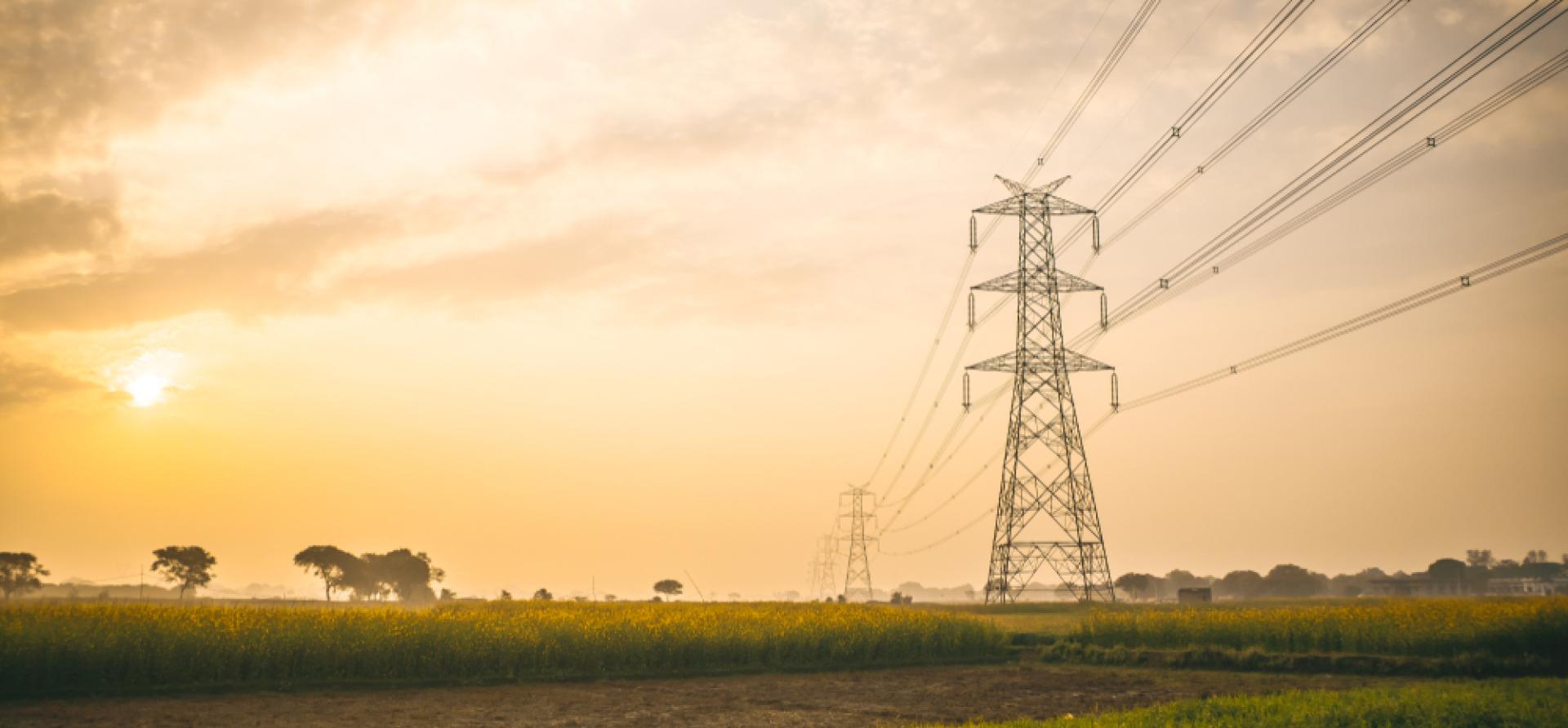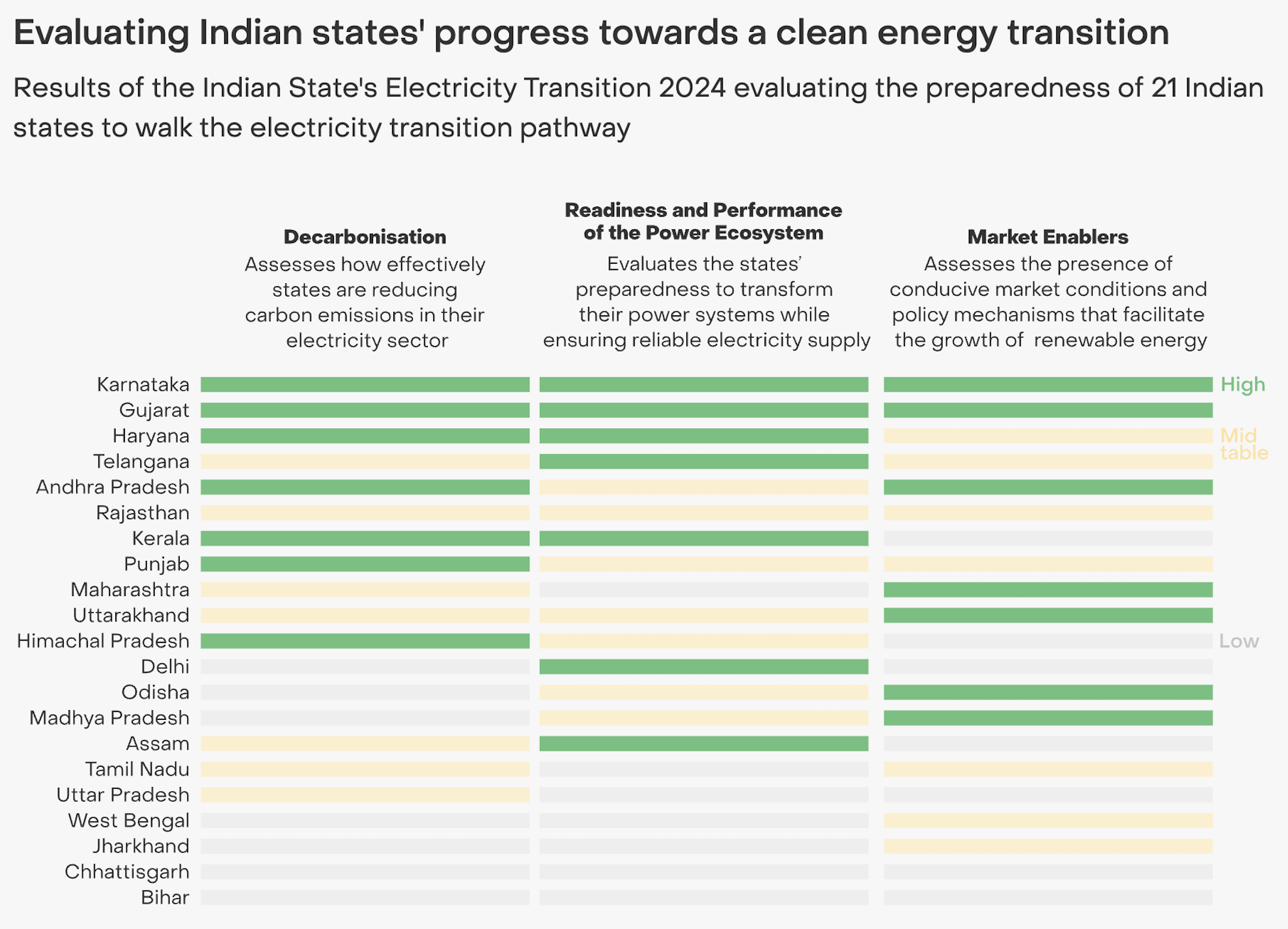
Key Findings
Karnataka and Gujarat, the top performers in SET 2023, were again exhibiting strength in 2024’s assessment parameters. These states have effectively integrated renewable energy sources into their power sectors, making big strides in decarbonisation, and are adequately prepared to accelerate the transition with robust market enablers facilitating future growth.
Odisha exhibits preparedness to embrace electricity transition through the readiness of its market enablers. However, it struggles with the actual decarbonisation of its power systems.
Kerala, Haryana, Andhra Pradesh, Punjab, Himachal Pradesh and Maharashtra all showed strong progress in one or more of the three dimensions: Decarbonisation, Readiness and Performance of the Power Ecosystem and Market Enablers. But they were also significantly slower in one of the three dimensions.
Jharkhand, Bihar, West Bengal and Uttar Pradesh move slowly than others again in SET 2024, despite the changes to our assessment parameters. There is a need to prioritise comprehensive strategies and interventions to foster sustainable growth and transition in their power sectors.
Executive Summary
India’s economic growth is fuelling a surge in electricity demand. Last year, with a 6.7% growth in gross domestic product (GDP), India’s electricity demand rose by a similar 7%. Demand is likely to grow at a similar pace of 6.5% from 2024 to 2026, according to the International Energy Agency.
Given that electricity generation continues to account for nearly half of India’s annual carbon dioxide (CO2) emissions (1.18 gigatonnes in 2023), accelerating the transition to cleaner generation sources is imperative for the country to meet both its developmental and climate goals.
While the central government has already taken several policy measures to foster the electricity transition, states also need to move in the right direction since they have considerable control over regulations and policies.
The first edition of the Institute for Energy Economics and Financial Analysis (IEEFA) and Ember’s State Electricity Transition (SET) report in 2023 analysed 16 Indian states to help identify the areas that require action and attention at the state level. This year’s report builds on that work by expanding the scope to 21 states. The dimensions and parameters for assessing states have also been refined to reflect the relevance of the parameters to the status of states’ electricity transition progress, feedback from stakeholders and data availability.
The exercise helped us identify some of the consistently top-performing states and those exhibiting signs of structural challenges when it comes to electricity transition.

Source: IEEFA and Ember Analysis
Gujarat and Karnataka are two states that have been the top performers across both iterations of the report despite a number of changes to the parameters this year. Specifically, in this year’s analysis, the states show that they have effectively integrated renewable energy into their power sectors, have adequate preparedness to further the electricity transition, and have robust market enablers to facilitate the future growth of clean electricity.
On the flipside, states such as Jharkhand, Bihar, West Bengal and Uttar Pradesh have showcased slower progress than others in most parameters across both iterations of the SET report. Although these states are early in their electricity transition journey, comparatively low performance across several parameters over two iterations of this report suggests structural challenges.
This year we noticed that these states were grappling with challenges to decarbonise their electricity systems, which were inadequately prepared to embrace the electricity transition. These states also need to improve their policies and market-enabling mechanisms to help pave the way for a clean future for their electricity sector.
One of the striking findings from our analysis for the 2024 report was that several states are exhibiting preparedness to embrace electricity transition, whether through the readiness of their power systems or having in place the right market enablers. However, they still struggle when it comes to the actual decarbonisation of their power systems.
Delhi and Odisha were the two notable examples in this regard. Despite significant strides in renewable energy infrastructure, Odisha struggles to make gains in decarbonisation. Similarly, Delhi too has a power system primed and ready for the electricity transition but requires better strategies to translate this strength into decarbonisation gains.
Another key theme emerging from the analysis is that several states have made uneven progress towards the electricity transition. While some lack the right market enablers, others struggle with the readiness of their power ecosystems.
Kerala, Haryana, Andhra Pradesh, Punjab and Maharashtra all exhibited considerable progress in certain aspects but also a significantly slower transition in other aspects. For example, Kerala and Punjab exhibit subpar performance in terms of market enablers for decarbonisation, while Andhra Pradesh and Maharashtra struggle with the readiness of their power ecosystems. Despite achieving relative success in decarbonising the sector thus far, states must address deficiencies in readiness and market enablers to sustain their momentum.
Overall, while recognising the considerable efforts states are making towards transitioning to clean electricity, we recommend the strengthening of state-level regulatory ecosystems.
Overall, while recognising the considerable efforts states are making towards transitioning to clean electricity, we recommend the strengthening of state-level regulatory ecosystems. This not only ensures compliance but also promotes growth, data tracking and monitoring, and a conducive environment for business. India has formulated many central and state-level policy schemes to reinforce its goal of energy independence by supporting various reforms and regulatory interventions across the value chain. However, actual implementation has not been adequate and transparent.
Further, there is also a need to shift focus from national-level to state-level studies to understand the nuances of electricity transition in India fully.
Each state presents unique challenges, resources and policies influencing the adoption of renewable energy sources. There is a need to develop state-level transition plans and trajectories, delve into state-level dynamics, and identify specific barriers and facilitators to provide a holistic view of the transition landscape.
To download the entire data set for this report, please click here.



















